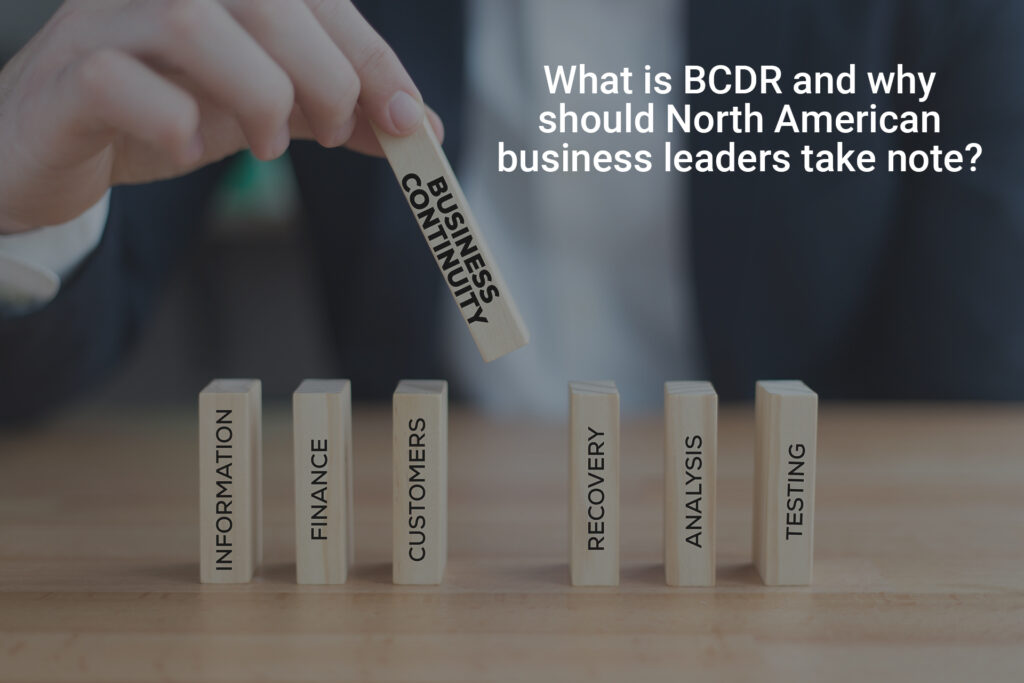In the current climate, business continuity and disaster recovery (BCDR) have a higher profile than ever before. Yet it often slips through the cracks of organizations’ day-to-day operations. Organizations of all sizes are increasingly dependent on digital technologies to generate revenue, provide services and support customers. However, to be able to do this, applications and data need to be available at all times. This means there is no time for downtime. Let’s take a closer look at BCDR and break it down by answering these three questions:
- What is the difference between business continuity and disaster recovery?
- What are the key elements of a BCDR plan?
- Why is BCDR important to North American organizations?
Businesses today face various threats that all have the potential to disrupt operations or take it offline completely. These disruptions aren’t just an inconvenience for customers. A disruptive event whether it’s a natural disaster, ransomware attack or other crisis can cause financial losses, brand and reputational damage and, in the worst-case scenario, cause the permanent closure of the business.
1. What is the difference between business continuity and disaster recovery?
Business continuity describes the processes and procedures an organization must put in place to ensure that mission-critical functions can continue during and after a disaster. In this sense, a business continuity plan is interchangeable with a disaster recovery plan. Business continuity, however, also addresses more comprehensive planning that focuses on long term or chronic challenges to organizational success. Potential business continuity problems may include the illness or departure of key team members, supply chain breakdowns, catastrophic failures, or critical malware infections.
Disaster recovery refers to specific steps taken to resume operations in the aftermath of a disruptive event, natural disaster, or emergency. These steps include, for example, restoring servers or mainframes with backups, re-establishing private branch exchanges and provisioning local area networks to meet immediate business needs.
2. What are the key elements of a BCDR plan?
A robust and resilient BCDR plan isn’t a one-size-fits-all approach. However, there are 4 key considerations that will position organizations for a successful recovery: resilience, recovery, contingency and continuous improvement. A BCDR solution should be able to withstand business interruptions and adverse conditions (resilience) and help organizations get back to business as fast as possible after a disaster or disruption (recovery). Further, having a complete set of measures and controls ready (contingency) will ensure a full recovery from the disruptive event. Overall, it is important to regularly review and update (continuous improvement) the BCDR plan to make provision for real-life scenarios and give organizations the best possible chance of navigating a disruption unscathed.
3. Why is BCDR important to North American organizations?
Combined, BCDR ensures that organizations remain operational during a disruptive event such as a fire, blackout or ransomware attack – the latter arguably today’s foremost cyber threat. In the event of a disruption, businesses must be able to quickly recover mission-critical data, restore IT systems and efficiently continue operations. A robust BCDR plan is essential for organizations that want to quickly recover with minimal disruption to the business.
To achieve these crucial BCDR objectives remains a substantial challenge. Organizational leaders struggle with securing organizational commitment and grapple with the challenge of finding a way to commit to spending time on issues unrelated to achieving daily goals and budgets. As a provider of BCDR solutions, Stage2Data has helped many clients navigate and survive disruptive events by converting manual BCDR processes into intelligent, automated workflows. To learn more about how we can put our expertise to work for your organization to minimize downtime from disruptive events, speak to one of our BCDR experts today.
Layman's Guide to
Business Continuity Planning
If you found this post interesting, you might enjoy these too:
COVID-19 Pandemic Recovery: Resilience is key to business continuity and disaster recovery
4 Disaster-Recovery-as-a-Service must-haves. Does your service provider include these?
Case Study: Onboarding Cohesity Improves Stage2Data’s Top and Bottom Lines



